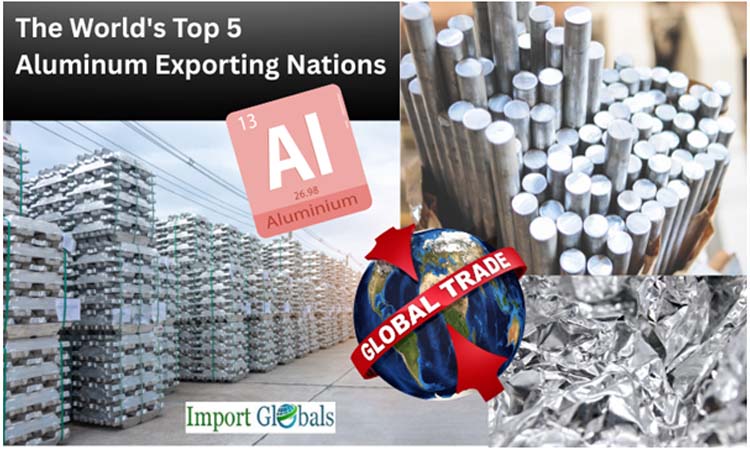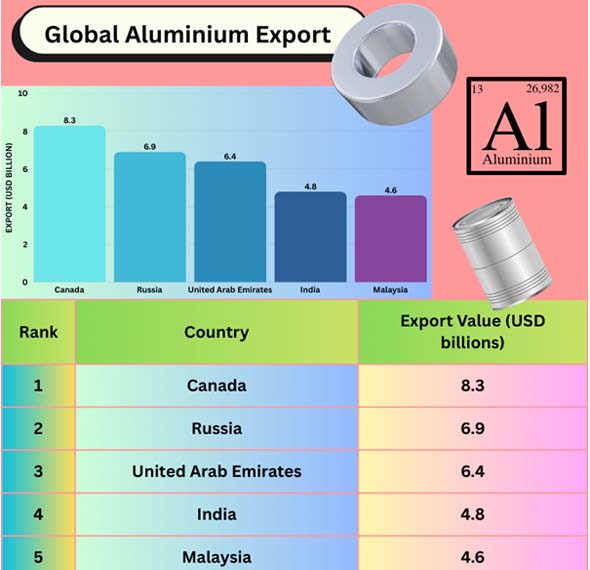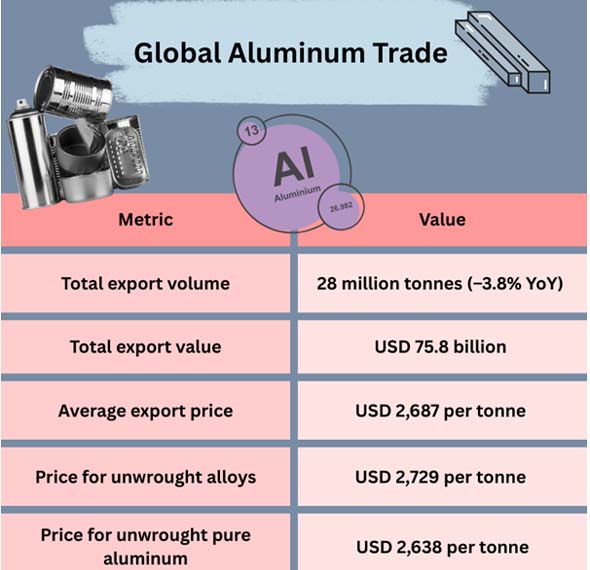
- Oct 14, 2025
The World's Top 5 Aluminum Exporting Nations
Because of its strength, durability, and ease of recycling, it has become indispensable in a variety of sectors, including electronics, automotive, aerospace, packaging, and construction. Some countries have become major exporters as a result of rising global demand, affecting industrial supply networks and trade flows.
This blog examines the trade strengths, economic strategies, and export values of the top five nations that will export aluminum. These countries collectively produce about three-quarters of the world's aluminum exports.

Canada is the World's Leading Nation
Canada Import Data by Import Globals indicates that with aluminum exports valued at USD 8.3 billion in 2024, or 11.5% of world exports, Canada is at the top of the list. Access to plentiful hydroelectric electricity, which is essential for the energy-intensive aluminum smelting process, is a major factor in the nation's supremacy.
Aluminum is very competitive in international markets thanks to the low-cost, eco-friendly aluminum produced by Canadian smelters. Another benefit is Canada's proximity to the US, one of the biggest aluminum users, which guarantees a steady export market. Political stability, effective trade logistics, and advanced infrastructure all help the Canadian aluminum sector. As a result, the country has established itself as a dependable provider during periods of interruption in international commerce.
Russia: A Robust Exporter Despite Obstacles
With a 9.6% worldwide share and USD 6.9 billion in aluminum exports, Russia comes in second. Rusal, one of the biggest producers of aluminum worldwide, is in charge of the nation's aluminum sector. Russia is a natural heavyweight in this industry because of its extensive bauxite deposits and well-established smelting capability.
However, based on Import Globals’ research on Russia Export Data, geopolitical tensions and sanctions have posed serious obstacles to Russia's aluminum commerce. Due to these limitations on access to Western markets, Russia has been forced to reroute its aluminum exports to Asia, especially China. Notwithstanding these challenges, the nation continues to be a vital provider to the world, demonstrating its ability to sustain export levels. Even as it adjusts to shifting geopolitical realities, Russia will remain a significant participant in the aluminum trade thanks to its competitive manufacturing costs, which are fueled by access to inexpensive energy and raw materials.
United Arab Emirates: The Middle East's Smelting Center
Third place goes to the United Arab Emirates (UAE), which exports aluminum valued at USD 6.4 billion, or 8.9% of worldwide exports. Through significant investments in smelting facilities, the United Arab Emirates has developed a robust aluminum sector despite not being a major source of bauxite. One of the biggest aluminum corporations in the world, Emirates Global Aluminium (EGA), is the foundation of this achievement. The UAE can produce more than 2.3 million tons a year thanks to state-of-the-art facilities like the DUBAL and EMAL smelters.
As per UAE Import Export Trade Data by Import Globals, low energy costs and vertically integrated processes, ranging from bauxite mining outside to smelting domestically, provide the UAE with a competitive edge. The UAE can effectively reach markets in Asia, Europe, and North America because of its strategic position. UAE aluminum shipments soared in 2025 as customers scrambled to get supplies before U.S. penalties. This illustrates the nation's adaptability and its increasing significance as a reliable international provider.
India: A Growing Exporter
With USD 4.8 billion in aluminum exports, or 6.7% of the world total, India comes in fourth place. With the help of significant corporations like Vedanta and Hindalco, the nation's aluminum industry has been growing quickly. India has improved its ability to produce and export bauxite thanks to its extensive local deposits and investments in state-of-the-art smelters.
According to India Import Data by Import Globals, international trade regulations, however, provide difficulties for India's aluminum exporters. India's export revenue was in danger of being cut by around USD 900 million in 2025 due to projected U.S. taxes on aluminum imports. As a result, Indian manufacturers are now looking into new markets in the Middle East, Southeast Asia, and Europe. India is still growing despite these obstacles, thanks to its low prices, robust internal market, and growing export potential. In the upcoming years, the nation is probably going to rise in the world rankings if manufacturing investment continues.
Malaysia: The New Challenger
Malaysia ranks fifth with USD 4.6 billion in aluminum exports, or 6.4% of worldwide exports. Despite not being regarded as a world leader in aluminum, Malaysia has gradually increased its market share. To increase exports, the nation has taken advantage of its advantageous Southeast Asian location, affordable labor, and trade-friendly laws. In 2024, Malaysian aluminum shipments increased by almost 6% year over year, indicating the country's growing significance in the global market.
Malaysia Import Trade Analysis by Import Globals suggests that processed aluminum products make up a substantial portion of Malaysia's exports, which boosts competitiveness and adds value. Malaysia is now a rapidly expanding exporter due to its expanding industrial base and close economic ties with China, Japan, and other regional countries.

Sustainability and Environmental Aspects of Aluminum Exports
Because it can be recycled, aluminum is sometimes referred to as the "green metal"; in fact, around 75% of all aluminum produced to date is still in use. But because of how energy-intensive the smelting process is, sustainability is a major issue in the sector. Based on Canada Export Data by Import Globals, to create low-carbon aluminum, nations like Canada and Norway use renewable hydroelectric power, which gives them a competitive advantage in markets that are calling for more environmentally friendly commodities.
To lessen their emissions impact, countries like the United Arab Emirates are making significant investments in energy-efficient smelters and carbon-capture technology. Exporters that can make more environmentally friendly aluminum will improve their long-term trade situations as companies throughout the world move toward sustainable sourcing.
Important Trends and Conclusions
- Energy Advantage: Countries like Canada and the United Arab Emirates that have inexpensive or renewable energy sources have a considerable economic advantage when it comes to producing aluminum.
- Geopolitical Factors: Exporters like Russia and India are being forced to diversify their markets as a result of sanctions and tariffs that are changing trade patterns.
- Emerging Players: As per Malaysia Export Import Global Trade Data, India and Malaysia serve as examples of how legislative backing and smart investments may swiftly raise a nation's standing in the world aluminum trade.
- Export Concentration: The top five exporters dominate the industry, accounting for more than 74% of worldwide commerce.
Because of this, the global market for aluminum exports is very concentrated, with a small number of nations influencing supply chains for businesses all over the world. As per Africa Import Data, Aluminum exports have a bright future due to demand from the packaging, automotive, renewable energy, and construction sectors. Over the next ten years, emerging markets, especially those in Asia and Africa, are anticipated to drive consumer growth. Export trends will still be impacted by changes in trade regulations, energy prices, and worldwide pricing volatility. Nations are likely to stay competitive if they invest in cutting-edge smelting technology and diversify their markets.
Furthermore, the future of the aluminum trade will depend on sustainable manufacturing methods as countries pledge to meet net-zero carbon objectives. Export executives who integrate innovation and green energy into their operations will not only hold onto their posts but also increase their influence internationally.
Conclusion
An essential component of international trade, the aluminum export sector influences sectors that depend on recyclable, strong, and lightweight materials. India and Malaysia are gradually rising in the rankings, but Canada, Russia, and the United Arab Emirates continue to be traditional leaders. As per Russia Import Trade Statistics by Import Globals, these five nations collectively produce about three-quarters of the world's aluminum exports, highlighting their crucial position in international supply chains.
One thing is certain: aluminum will continue to be a vital component of the global economy, and these five countries will be at the forefront of its commerce. Future energy trends, trade regulations, and geopolitical events will continue to influence the landscape. Import Globals is a leading data provider of Canada Import Export Trade Data. Subscribe to Import Globals to get more global trade details!
FAQs
Que. Which nation is the largest exporter of aluminum?
Ans. With shipments of USD 8.3 billion in 2024, or 11.5% of worldwide aluminum exports, Canada is the greatest exporter of aluminum in the world.
Que. What is the connection between energy availability and aluminum production?
Ans. As per UAE Import Export Trade Analysis, Smelting aluminum uses a lot of energy. A competitive edge is gained by nations having cheap and plentiful energy, such as Canada's hydroelectric power or the United Arab Emirates' inexpensive electricity.
Que. What impact have sanctions had on Russia's shipments of aluminum?
Ans. Although sanctions have made it harder for Russia to access Western markets, the nation has managed to be a leading exporter by shifting its products to Asia, especially China.
Que. Which nations are becoming new exporters of aluminum?
Ans. Malaysia and India are developing quickly. Both nations' exports have grown dramatically in recent years; in 2024 alone, Malaysia's sales climbed by more than 6%.
Que. Where can you obtain detailed Russia Import Shipment Data?
Ans. Visit www.importglobals.com or email info@importglobals.com for more information on up-to-date data.
